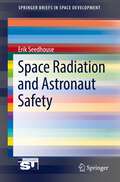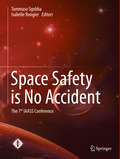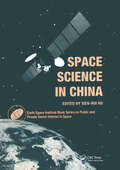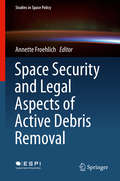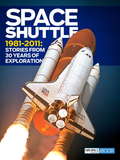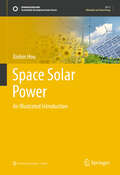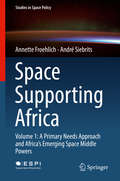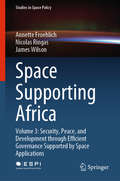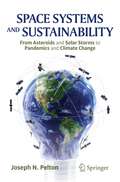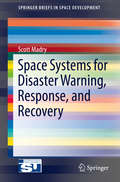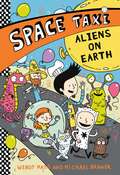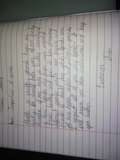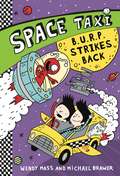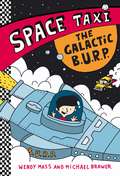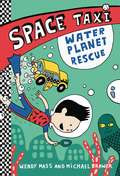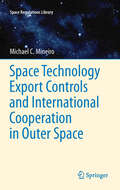- Table View
- List View
Space Radiation and Astronaut Safety (Springerbriefs In Space Development Ser.)
by Erik SeedhouseThis brief explores the biological effects of long-term radiation on astronauts in deep space. As missions progress beyond Earth's orbit and away from the protection of its magnetic shielding, astronauts risk constant exposure to higher levels of galactic cosmic rays and solar particle events. The text concisely addresses the full spectrum of biomedical consequences from exposure to space radiation and goes on to present possible ways to mitigate such dangers and protect astronauts within the limitations of existing technologies.
Space Safety is No Accident
by Tommaso Sgobba Isabelle RongierIncludes the proceedings from the 7th IAASS Conference, "Space Safety is No Accident," held in Friedrichshafen, Germany, in October 2014. The 7th IAASS Conference, "Space Safety is No Accident" is an invitation to reflect and exchange information on a number of topics in space safety and sustainability of national and international interest. The conference is also a forum to promote mutual understanding, trust and the widest possible international cooperation in such matters. The once exclusive "club" of nations with autonomous sub-orbital and orbital space access capabilities is becoming crowded with fresh and ambitious new entrants. New commercial spaceports are starting operations and others are being built. In the manned spaceflight arena a commercial market is becoming a tangible reality with suborbital spaceflights and government use of commercial services for cargo and crew transportation to orbit. Besides the national ambitions in space, the international cooperation both civil and commercial is also gaining momentum. In the meantime robotic space exploration will accelerate and with it the need to internationally better regulate the usage of nuclear power sources. Space-bound systems and aviation traffic will share more and more a crowded airspace, while aviation will increasingly rely on space-based safety-critical services. Finally, most nations own nowadays space assets, mainly satellites of various kinds and purposes, which are under the constant threat of collision with other spacecraft and with the ever increasing number of space debris. Awareness is increasing internationally (as solemnly declared since decades in space treaties) that space is a mankind asset and that we all have the duty of caring for it. Without proactive and courageous international initiatives to organize space, we risk to negate access and use of space to future generations.
Space Science in China (Earth Space Institute Book Ser. #Vol. 1)
by Wen-Rui HuSpace science in China is one of the most active areas in modern science, and China has played a dynamic and steadily increasing role in this field since the 1960s. Until recently, however, activity in China was a mystery to the rest of the world. With the commercial importance of space, and the fact that space is now used as a laboratory to carry out various experiments, China has recently emerged as an important international competitor. Space Science in China provides a clear understanding of the latest research and progress in such wide-ranging areas as the development and research in solar-terrestrial science, space astronomy, geoscience, remote sensing, microgravity science, and life science.
Space Science, Module H (HMH Science Dimensions™)
by Marjorie Frank Michael R. Heithaus Michael A. DiSpezioNIMAC-sourced textbook
Space Security and Legal Aspects of Active Debris Removal (Studies in Space Policy #16)
by Annette FroehlichThe book analyzes the various legal and political concepts to resolve the problem of the existing space debris in outer space and which measures have been taken to avoid space debris or to reduce potential space debris in the course of future space missions. From a scientific and technical point of view various studies are ongoing to analyze the feasibility of active debris removal. Nevertheless it has to be highlighted that outer space is an international area where various actors with different legal and political concepts are operating, a situation that leads to different approaches concerning such activities.
Space Shuttle 1981-2011
by Sally Ride T. A. Heppenheimer Air Space Magazine Greg FreiherrSpace Shuttle 1981-2011 is a lavishly illustrated special edition celebrating the space shuttle era. In thirty years of operation, space shuttles were used in 135 different missions; this volume presents the adventure stories of many of these missions in the astronauts' own words. Additional contributions by space exploration writers cover the history of the program, technological challenges and triumphs, scientific achievements, and the devastating Challenger and Columbia tragedies. Complete with more than 40 essays and 100 full-color photographs, Space Shuttle 1981-2011 is a captivating overview of this critical part of space history. Although the space shuttle era has ended, its spirit--that of limitless curiosity and a desire for perfection--continues to inspire.
Space Solar Power: An Illustrated Introduction (Sustainable Development Goals Series)
by Xinbin HouThis book highlights a comprehensive introduction to space solar power, covering the history, latest developments, system composition, and key technologies. With the backdrop of global climate change and the aim towards carbon neutrality, space solar power offers a sustainable and clean energy option for humanity. This book, filled with colorful graphics, provides an engaging reading experience for readers to easily grasp this exciting form of power generation in space. It covers key technologies such as high-power solar energy generation in space, wireless energy transmission, and the transportation and construction modes of space solar power stations. The author also introduces typical system schemes, highlighting the Multi-Rotary joints SPS as a significant example. Designed for college students majoring in astronomy, aeronautics, energy, and engineering, this book expands their understanding of space exploration and the innovative development of clean energy sources. It also serves as a valuable reference for researchers and engineers involved in space solar power research. The English translation of this book, originally in Chinese, was facilitated by artificial intelligence. The content was later revised by the author for accuracy.
Space Studies Board Annual Report 2013
by Space Studies BoardThe original charter of the Space Science Board was established in June 1958, 3 months before the National Aeronautics and Space Administration (NASA) opened its doors. The Space Science Board and its successor, the Space Studies Board (SSB), have provided expert external and independent scientific and programmatic advice to NASA on a continuous basis from NASA's inception until the present. The SSB has also provided such advice to other executive branch agencies, including the National Oceanic and Atmospheric Administration (NOAA), the National Science Foundation (NSF), the U.S. Geological Survey (USGS), the Department of Defense, as well as to Congress. Space Studies Board Annual Report 2013 covers a message from the chair of the SSB, Charles F. Kennel. This report also explains the origins of the Space Science Board, how the Space Studies Board functions today, the SSB's collaboration with other National Research Council units, assures the quality of the SSB reports, acknowledges the audience and sponsors, and expresses the necessity to enhance the outreach and improve dissemination of SSB reports. This report will be relevant to a full range of government audiences in civilian space research - including NASA, NSF, NOAA, USGS, and the Department of Energy, as well members of the SSB, policy makers, and researchers.
Space Studies Board Annual Report 2013
by Space Studies BoardThe original charter of the Space Science Board was established in June 1958, 3 months before the National Aeronautics and Space Administration (NASA) opened its doors. The Space Science Board and its successor, the Space Studies Board (SSB), have provided expert external and independent scientific and programmatic advice to NASA on a continuous basis from NASA's inception until the present. The SSB has also provided such advice to other executive branch agencies, including the National Oceanic and Atmospheric Administration (NOAA), the National Science Foundation (NSF), the U.S. Geological Survey (USGS), the Department of Defense, as well as to Congress. Space Studies Board Annual Report 2013 covers a message from the chair of the SSB, Charles F. Kennel. This report also explains the origins of the Space Science Board, how the Space Studies Board functions today, the SSB's collaboration with other National Research Council units, assures the quality of the SSB reports, acknowledges the audience and sponsors, and expresses the necessity to enhance the outreach and improve dissemination of SSB reports. This report will be relevant to a full range of government audiences in civilian space research - including NASA, NSF, NOAA, USGS, and the Department of Energy, as well members of the SSB, policy makers, and researchers.
Space Studies Board Annual Report 2013
by Space Studies BoardThe original charter of the Space Science Board was established in June 1958, 3 months before the National Aeronautics and Space Administration (NASA) opened its doors. The Space Science Board and its successor, the Space Studies Board (SSB), have provided expert external and independent scientific and programmatic advice to NASA on a continuous basis from NASA's inception until the present. The SSB has also provided such advice to other executive branch agencies, including the National Oceanic and Atmospheric Administration (NOAA), the National Science Foundation (NSF), the U.S. Geological Survey (USGS), the Department of Defense, as well as to Congress. Space Studies Board Annual Report 2013 covers a message from the chair of the SSB, Charles F. Kennel. This report also explains the origins of the Space Science Board, how the Space Studies Board functions today, the SSB's collaboration with other National Research Council units, assures the quality of the SSB reports, acknowledges the audience and sponsors, and expresses the necessity to enhance the outreach and improve dissemination of SSB reports. This report will be relevant to a full range of government audiences in civilian space research - including NASA, NSF, NOAA, USGS, and the Department of Energy, as well members of the SSB, policy makers, and researchers.
Space Studies Board: Annual Report 2009
by National Research Council of the National AcademiesThe Space Studies Board (SSB) was established in 1958 to serve as the focus of the interests and responsibilities in space research for the National Academies. The SSB provides an independent, authoritative forum for information and advice on all aspects of space science and applications, and it serves as the focal point within the National Academies for activities on space research. It oversees advisory studies and program assessments, facilitates international research coordination, and promotes communications on space science and science policy between the research community, the federal government, and the interested public. The SSB also serves as the U.S. National Committee for the International Council for Science Committee on Space Research (COSPAR). The present volume reviews the organization, activities, and reports of the SSB for the year 2009.
Space Studies Board: Annual Report 2014
by National Research Council of the National AcademiesUnder the leadership of Jonathan Lunine and Mitch Daniels, the Committee on Human Spaceflight completed one of the most challenging studies undertaken by the Space Studies Board and the Aeronautics and Space Engineering Board. In Pathways to Exploration: Rationales and Approaches for a U.S. Program of Human Exploration, a diverse committee of experts tackled not only the question, How should humans explore space?, but the even more challenging question, Why should humans explore space? <P> The committee identified a pair of enduring questions that motivate human spaceflight: How far from Earth can humans go? and What can humans discover and achieve when we get there? The committee then explored a range of rationales for human spaceflight ranging from the pragmatic (its economic, national security, scientific exploration, international relations, and technology impacts) to the aspirational—the notion that space is humanity’s future. While the committee did not identify a single rationale as the primary justification for space exploration and could not quantify the economic benefit of space exploration, it did conclude that a mix of rationales motivates space exploration. <P><P> Along with an examination of public and stakeholder attitudes about human exploration, the report evaluated three different pathways to illustrate the trade-offs among affordability, schedule, developmental risk, and the frequency of missions for different sequences of intermediate destinations. The pathways, all of which culminate in landing on the surface of Mars, include some combination of missions to asteroids, the Moon, and martian moons.
Space Supporting Africa: Volume 1: A Primary Needs Approach and Africa’s Emerging Space Middle Powers (Studies in Space Policy #20)
by Annette Froehlich André SiebritsIn this book the background and context of Africa’s political and socio-economic landscape is presented and unpacked through a primary needs approach which focuses on climate, biodiversity, health, water, education, and space-related capacity building. African theoretical contributions from the International Relations field are discussed, and Africa’s new Space Policy and Strategy, along with debates around the establishment of an African Space Agency, are explored. The African International Space Ecosystem is then analyzed, including its dimensions of intra-African space relations and initiatives, African participation in COPUOS, and international space activities, agreements, and initiatives in Africa. The final part is dedicated to the national space infrastructure and activities of African states.
Space Supporting Africa: Volume 3: Security, Peace, and Development through Efficient Governance Supported by Space Applications (Studies in Space Policy #28)
by James Wilson Annette Froehlich Nicolas RingasAfrica faces numerous challenges relating to good governance due to its vast and diverse landscape, as well as its history. This book explores the role of space-based applications in supporting African good governance by strengthening civil society, bolstering democratic processes and advancing socio-economic development. The increased use of such applications can accelerate Africa's progress towards the United Nations Agenda 2030 Sustainable Development Goals, as well as the African Union's Agenda 2063 aspirations This book examines key challenges facing governance within African to provide an accurate account of the current African context. It discusses specific examples of e-governance and digital solutions that leverage space-based technologies and have been successfully implemented in both the developed and developing world. In the context of the numerous satellite constellations being deployed to provide affordable Internet connectivity globally, it examines the major actors in this sector and presents additional governance solutions based on remote sensing and Earth observation data. Given its scope, the book will be of interest to professionals and students in the fields of development, governance and space studies.
Space Supporting Latin America: Latin America's Emerging Space Middle Powers (Studies in Space Policy #25)
by Annette Froehlich Diego Alonso Amante Soria Ewerton De MarchiThis book examines the background and context of Latin America's political and socioeconomic landscape with a focus on space activities. Firstly, it discusses Latin America's contribution to this sector from an international relations perspective, and explores the debates around the establishment of a Latin American Space Agency. It then highlights space-related capacity building, Latin America’s participation in UNCOPUOS, and international space activities, agreements, and initiatives in Latin America. The second part is devoted to the national space infrastructures and space activities of Latin American states. It analyzes various spacefaring countries in the context of their intra-regional space relations and initiatives as well as their bi-lateral cooperation programs. This timely book is of interest to scholars and professionals working in the space field, especially those in Latin America and other emerging countries.
Space Systems and Sustainability: From Asteroids and Solar Storms to Pandemics and Climate Change
by Joseph N. PeltonIn his latest book, space scientist, futurist, and educator Joseph N. Pelton explores adozen ways that Planet Earth is at “existential” risk, along with the many ways thatspace systems, data analytics, and advanced networking systems can help us copewith these global challenges.The chapters examine in a straightforward way how satellite systems and technol-ogy can drastically transform fields such as pandemic tracking and global medicalresponses, cosmic hazard monitoring, nuclear energy and waste disposal, water andland pollution, tele-education/telemedicine, and military conflict. Such examplesshow how orbiting smart systems will play an ever more vital role in our vulnerablemodern world, allowing us to monitor, track, and respond to mounting problems ofthe 21st century.Dr. Pelton takes a broad view, probing the social, economic, and regulatory factorsthat are crucial to creating a more sustainable “Spaceship Earth.” This book is a callto action, promoting more organized international collaboration and investment in space technologies that can enable global change.
Space Systems for Disaster Warning, Response, and Recovery
by Scott MadryThis SpringerBrief provides a general overview of the role of satellite applications for disaster mitigation, warning, planning, recovery and response. It covers both the overall role and perspective of the emergency management community as well as the various space applications that support their work. Key insights are provided as to how satellite telecommunications, remote sensing, navigation systems, GIS, and the emerging domain of social media are utilized in the context of emergency management needs and requirements. These systems are now critical in addressing major man-made and natural disasters. International policy and treaties are covered along with various case studies from around the world. These case studies indicate vital lessons that have been learned about how to use space systems more effectively in addressing the so-called "Disaster Cycle. " This book is appropriate for practicing emergency managers, Emergency Management (EM) courses, as well as for those involved in various space applications and developing new satellite technologies.
Space Taxi: Aliens on Earth (Space Taxi #6)
by Wendy Mass Michael BrawerArchie Morningstar fights crime across the universe alongside his dad and Pockets the talking cat. In his sixth adventure, the space taxi navigation system goes down, stranding all the alien passengers on Earth! Will the team be able to find hiding spots for these otherworldly creatures before they're discovered, or will this be the end of the operation for good? Get ready for another exciting intergalactic adventure.
Space Taxi: Archie Takes Flight (Space Taxi #1)
by Wendy Mass Michael Brawer Elise GravelArchie Morningstar learns a big family secret and helps save the universe. All before breakfast!It's not every day a regular kid like Archie gets to wake up at midnight. But today is Take Your Kid to Work Day, and Archie is finally allowed to ride along in his dad's taxi cab. He has been waiting eight years, eight months, and eight days for this moment to arrive.But he's about to discover his dad is no ordinary cab driver...In fact, he drives an intergalactic space taxi! All night long, he shuttles aliens from one corner of the universe to another. And being a space taxi copilot is no easy task: Archie must steer them into wormholes, keep them from crashing into planets, deal with a very unusual cat...and save the universe from an evil mastermind!Space Taxi marks the debut of a brand new chapter book series from New York Times bestselling author Wendy Mass and teacher Michael Brawer, filled with humor, adventure, and plenty of science to impress your friends and teachers!
Space Taxi: Archie's Alien Disguise (Space Taxi #3)
by Wendy Mass Michael BrawerArchie Morningstar's dad drives a taxi through outer space! And with the help of a talking cat named Pockets, Archie and his dad help fight crime across the universe.In the third book in the series, Archie, his dad, and Pockets visit a planet that resembles medieval Earth in every way but its inhabitants, who have rainbow colored hair and extra eyes. To beat the evil organization B.U.R.P., the trio must disguise themselves as aliens and rescue a princess! When Archie must act on his own, can he find the courage to save the day?
Space Taxi: B.U.R.P. Strikes Back (Space Taxi #5)
by Wendy Mass Michael BrawerBook five in the intergalactic science-based chapter book series from New York Times bestselling author Wendy Mass and Michael Brawer! Archie Morningstar fights crime across the universe alongside his dad and Pockets the talking cat. In Archie's fifth adventure, Pockets is in a panic: all the tuna fish sandwiches on Akbar's Floating Rest Stop have been stolen! He thinks it's the fault of the irritating head of his alien fan club, but Archie suspects the mystery goes much deeper. Get ready for another thrilling and hilarious space adventure!
Space Taxi: The Galactic B.U.R.P. (Space Taxi #4)
by Wendy Mass Michael BrawerArchie Morningstar's dad drives a taxi through outer space! And with the help of a talking cat named Pockets, Archie and his dad help fight crime across the universe.In this fourth book in the series, Archie is taken to the criminal organization B.U.R.P.'s mothership where he must outsmart evil masterminds!
Space Taxi: Water Planet Rescue (Space Taxi #2)
by Wendy Mass Michael BrawerArchie Morningstar's dad drives a taxi through outer space! And with the help of a talking cat named Pockets, Archie and his dad help fight crime across the universe.In the second book in this series, Archie, his dad, and Pockets fly to a planet in peril: someone is stealing the water from this underwater world! Can Archie and Pockets save the day?
Space Technology Export Controls and International Cooperation in Outer Space
by Michael MineiroExport controls definitively impact international cooperation in outer space. Civil and commercial space actors that engage in international endeavors must comply with space technology export controls. In the general discourse, members of the civil and commercial space community have an understanding of their domestic export control regime. However, a careful reading of the literature on space technology export controls reveals that certain questions relevant to international engagements have not been identified or answered. What is the legal-political origin of space technology export controls? How do they relate to the current international legal structure? What steps can be taken to evolve our current unilateral paradigm of space technology within the context of peaceful exploration and use of outer space? In this book, these and other relevant questions on space technology export controls are identified and assessed through an insightful case-study of the U.S. commercial communication export control regime. The findings of this case-study are used in an international legal-political analysis of international space law, public international law, and international cooperation. Breaking new ground in international legal theory, a self-justified security dilemma that is manifest in international law is identified and explained as the origin for the current paradigm of space technology export controls.
